Glyphs Collection
"Unveiling the Ancient Language: Exploring the Enigmatic World of Glyphs" Typesetter at work, meticulously crafting intricate symbols that hold stories untold
All Professionally Made to Order for Quick Shipping
"Unveiling the Ancient Language: Exploring the Enigmatic World of Glyphs" Typesetter at work, meticulously crafting intricate symbols that hold stories untold. The artistry and precision required to bring these ancient glyphs to life is truly awe-inspiring. The Theban alphabet, also known as the Runes of Honorius, whispers secrets from a bygone era. Each symbol holds power and meaning, unlocking a hidden language understood only by those initiated into its mysteries. Traveling through time, we encounter the enigmatic Maya calendar adorned with mesmerizing glyphs. These sacred markings served as a guide to their complex cosmology and understanding of time itself. Delving deeper into Mayan culture, vessels depicting mythological scenes transport us to an era where gods and heroes roamed freely. Created by unknown artisans between A. D. 600-800, these vessels are adorned with captivating glyphs that narrate tales lost in history's embrace. Ah Maxam's masterpieces come alive on water-lily vessels and dancing lords' jars. Adorned with vibrant colors and intricate details, these artifacts showcase glyphic narratives that celebrate Mayan traditions and beliefs. Jaguar paraphernalia adorns a jar depicting a man dancing passionately – his movements echoing ancient rituals preserved through beautifully engraved glyphs. This artwork serves as a testament to the profound connection between humans and nature in Mesoamerican cultures. Venturing beyond Mayan realms, we stumble upon an engraving revealing the Hand of Palmistry from Heinrich Cornelius Agrippa von Nettesheim's works. Here too, glyphs play their part in unraveling destinies written on palms for centuries past. A cylindrical vessel transports us back to Late Classic period ball games where athletes battled fiercely for honor and glory amidst cheering crowds. Glyphs etched onto this ceramic artifact capture moments frozen in time – echoes of triumphs long forgotten but forever immortalized within their strokes.


























